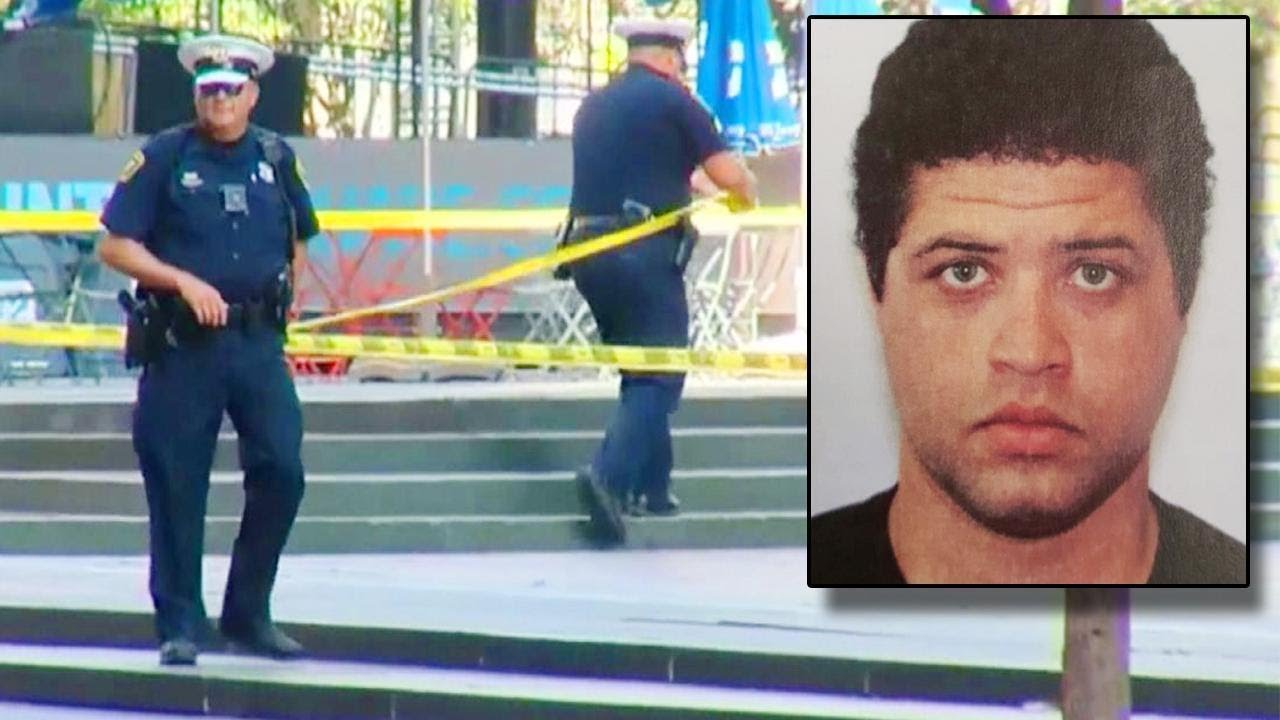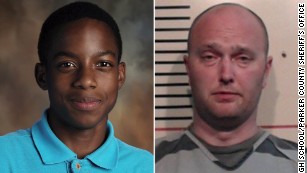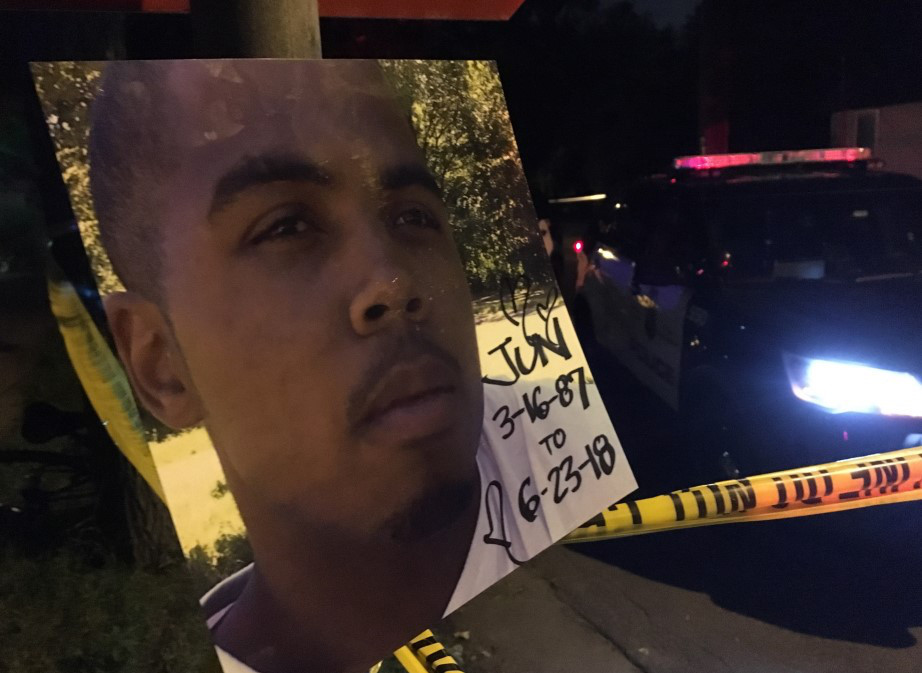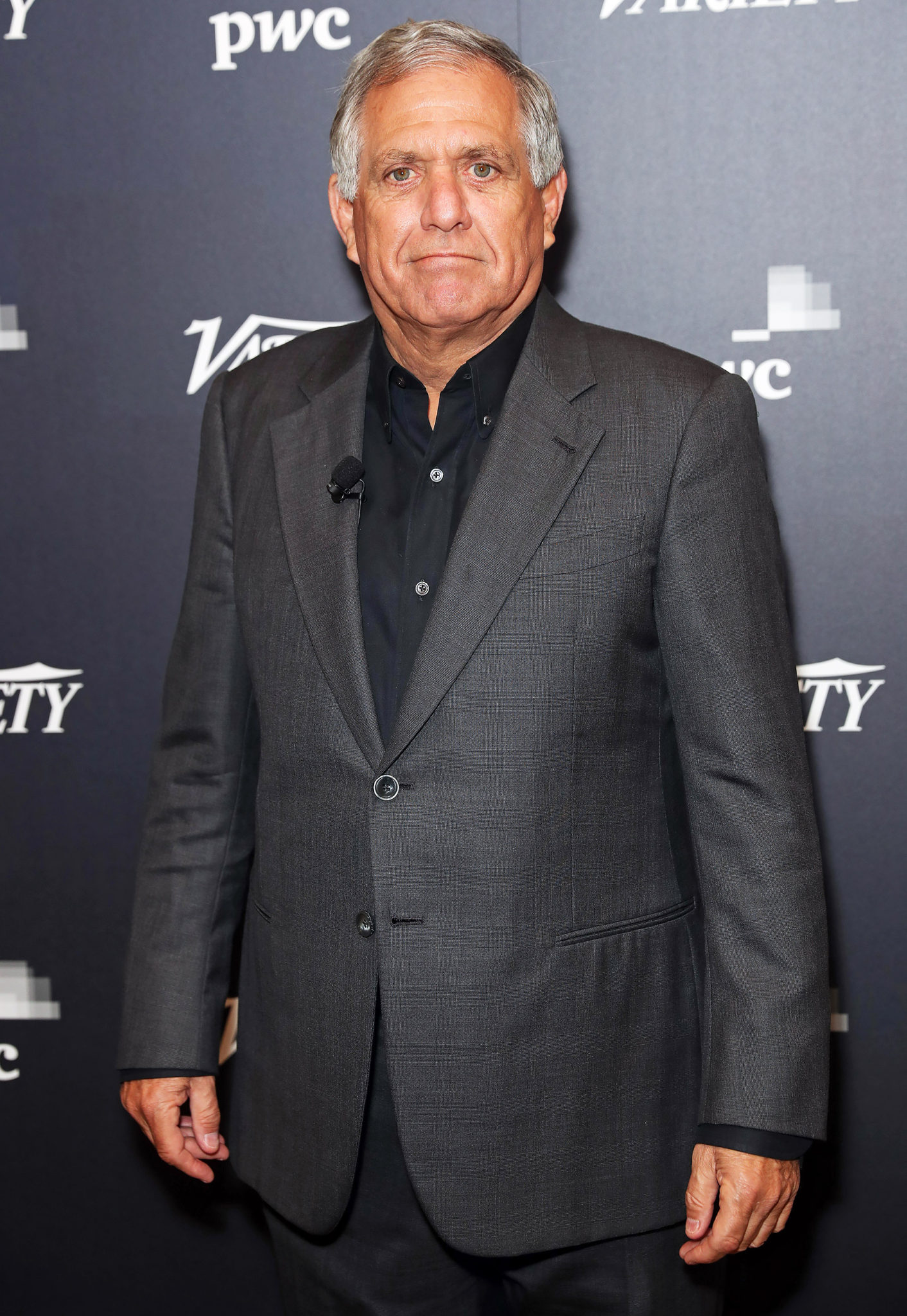
In Cincinnati, a gunman opened fire at a downtown bank, killing three people and injuring two others before he was shot and killed by police. Cincinnati Police Chief Eliot Isaac said the gunman, who they believe acted alone, fired more than a dozen shots from a legally purchased 9-millimeter semiautomatic pistol. Authorities have identified the gunman as Omar Perez, though a motive for the shooting is still under investigation. The gun used in the shooting was recovered at the scene along with multiple magazines and around 200 rounds of ammunition.
Police say Perez, 29, of Northbend, Ohio, has no known connection to the bank and it is unclear how he got to Fountain Square but that he entered multiple businesses before going to the bank. He opened fire in the building’s loading dock before continuing into the lobby area and firing more shots. Officers responded to a 911 call around 9:10 a.m. local time about an “active shooter” at the bank. Multiple officers then “engaged” the suspect, who was fatally shot multiple times.
Five people were shot, some multiple times, including three who died from their injuries. One person died at the scene and two victims died at the hospital. Those killed in the shooting were a grandfather, a father and a son. Richard Newcomer, 64, a father of 3 and grandfather of 8, who was supervising a construction project on the building’s third floor was shot as he entered the building. Luis Calderón, 48, a father to a 13 year old and 16 year old, was also killed as he arrived to work. He had moved to Cincinnati last year to work for the bank and provide a better life for his children. The third victim was identified as Prudhvi Raj Kandepi, 25, a programmer and consultant for Fifth Third who was described by family as someone who would give everything he could to friends and family.
Police have released security footage of the gunman “firing shots at anyone he sees” while inside the lobby of the building. The security footage shows Omar Enrique Santa Perez walking in the lobby with his gun held up and carrying a briefcase containing hundreds of rounds of ammunition over his shoulder. A security officer was seen helping people get to a safe location as the gunman was randomly firing shots at anyone he sees. Perez then turns toward the windows and fires shots at approaching officers. The body camera footage shows officers approaching the gunman and shooting through the glass of the lobby. The officers on the scene engaged the shooter within three and a half minutes of the first 911 call and fired 11 shots, taking out the gunman. Police later found that Perez’s gun had jammed during the four-minute rampage.
Cincinnati Mayor John Cranley praised the officers for ending the shooting quickly. “You could see in the video … the guy is shooting at the cops, you can see them not being afraid and engaging and ending it.” “If he had gotten on the elevator, gone up to a floor, if he had been there earlier or a little bit longer, many more people would have been killed.”
Fifth Third Bank is headquartered in Cincinnati but has locations across 10 states. The company released a statement via Twitter. “Earlier today, an active shooter entered our headquarters building in downtown Cincinnati. The situation is contained and the shooter is no longer a threat. Our thoughts and prayers are with everyone caught up in this terrible event. We continue to work with law enforcement as we ensure the safety of our employees and customers. We are grateful for the support and concerns from our neighbors throughout Cincinnati and the country.”
Read more

In Jacksonville, Florida, authorities say a man opened fire at a restaurant hosting a Madden 19 video game tournament, killing two people and wounding 10 before killing himself. One person was also injured while trying to escape. The shooter has been identified as David Katz, a 24-year-old gamer from Baltimore, Maryland. Katz’s motive in the shooting remains under investigation, police said.
Katz, like many other gamers, was in town for the tournament at GLHF Game Bar at the Jacksonville Landing, a downtown shopping and dining complex. Witnesses said he had been eliminated from the tournament the day before when two other players beat him. Dennis Alston, one of the gamers who beat Katz, said that he tried to shake the shooter’s hand after the game but that Katz refused his hand and stared at him blankly. Alston said that he noticed Katz had returned to the tournament the following day wearing the same clothes.
Katz went by the gaming naming “Bread” and previously won Madden tournaments in 2017. Authorities say Katz walked past patrons in other parts of the restaurant and then opened fire on his fellow competitive gamers before killing himself. The Jacksonville Sheriff’s Office identified the victims as Eli Clayton, 22, and Taylor Robertson, 28. Both were competitive Madden players, and Robertson had won the Madden Classic. Authorities said Katz had legally purchased two weapons in Baltimore over the past month and one of the weapons had a laser sight that attached to the gun.
Gunshots and piercing screams echoed through the Twitch live stream of the tournament in real time, leaving millions of helpless online viewers shocked before the live stream was cutoff. Shortly after 1:30 p.m., 911 calls started pouring in about a shooting and officers were on the scene within two minutes. About a dozen firefighters with the Jacksonville Fire and Rescue Department were training in the structure just north of the Landing when the gunfire rang out.
They treated the “walking wounded” outside the restaurant, then made their way inside to find flipped tables and broken dishes scattered across the floor. They made their way through the restaurant and found the three deceased in the gaming room: Taylor Robertson, 27, of Ballard, West Virginia; Eli Clayton, 22, of Woodland Hills, California; and the shooter, later identified as David Katz, 24, of Baltimore.
Both Elizabeth and Richard Katz are cooperating with investigators and have told authorities that their son had mental health issues. Katz underwent treatment for psychological and emotional issues during his parents’ divorce and highly contentious custody battle in 2006. He was once placed on an antipsychotic medicine used to treat schizophrenia. The alleged gunman was also placed on two antidepressants.
Read more

Former Balch Springs, TX police officer Roy Oliver, 38, was found guilty of murder in the shooting of Jordan Edwards, an unarmed teen who was a passenger in a car that had left a party. Oliver was fired by the Balch Springs Police Department just days after the shooting for violating several departmental policies. A Texas jury sentenced Oliver to 15 years in prison and imposed a $10,000 fine for the murder of the 15-year-old honor student. The jury found Oliver not guilty on two counts of aggravated assault.
During the trial Oliver claimed that he fired at the car after seeing it move toward his partner, Officer Tyler Gross, and thought Gross’s life was in danger. Officer Gross testified that he did not fear for his life and didn’t feel the need to fire his own weapon. Oliver faced up to life in prison on the murder conviction. Prosecutors were pushing for at least 60 years in prison, while defense argued for 20 years or less. Oliver’s mother and wife asked for a lenient prison sentence. His wife, Ingrid Llerena, testified that she’s concerned about their 3-year-old son, who is autistic, and the boy’s future without his father at home.
In April 2017, the police were responding to a call about a house party when they encountered Jordan, his brothers and his friends in their car, attempting to leave. The officers first claimed that the boys were “backing down the street toward officers in an aggressive manner,” before later retracting that statement and acknowledging that the teens had been driving away.
Police body cam video shows Oliver fired his assault rifle into the car carrying the five teenagers as they drove away from the officer, hitting Jordan in the head. One of the car’s passengers says the officer never even ordered the boys to stop driving before opening fire. Edwards, was shot in the head as he was sitting in the front passenger seat of the car, along with his two brothers and two friends.
Jordan’s father Odell, said that his son Vidal, continued driving away so that no one else would be shot. He stopped the car two blocks from the party and called his father while his two friends in the back seat called their parents. “All I could hear was screaming and crying and the boys saying that police had just shot and killed Jordan. Jordan Edwards was a freshman at Mesquite High School and a straight A student with a 4.0 GPA who played quarterback and receiver on the football team. He lived in an upper middle class neighborhood in Balch Springs with his parents, two older brothers and younger sister.
Dallas County District Attorney Faith Johnson described Oliver as a “killer in blue” who violated his oath to protect citizens. Johnson said she wished Oliver’s sentence was much longer, but she respected the jury’s decision and realizes a guilty verdict for an officer is rare in police shootings. Charmaine Edwards said she would have preferred a sentence of 25 to 30 years for the killer of the stepson she raised. “That was my exact thought: They gave a year for his age,” Edwards, said outside a Dallas County courtroom after the sentence was handed down. “He can actually see life again after 15 years, and that’s not enough because Jordan can’t see life again.”
Read more

A New York Times report revealed that Italian actress Asia Argento recently quietly paid former co-star Jimmy Bennett $380,000 after he accused her of sexually assaulting him in 2013, when Bennett was 17 and Argento was 37. The age of consent in the state of California is 18. Argento emerged as a leader in the #MeToo movement after she was one of the first of more than 100 women to accuse disgraced Hollywood mogul Harvey Weinstein of rape and sexual harassment. The Times reports that she paid off Bennett months after she spoke out publicly against Weinstein and that it has seen the legal documents that lay out Bennett’s assault claims and the payments arranged between his lawyers and Argento’s.
Bennett’s lawyers sent a notice of intent to sue Argento to her lawyers in November, claiming that the sexual assault was so traumatic that it affected his mental health and stymied his acting career. In the documents, Bennett claims that he arrived at the Ritz-Carlton in Marina del Rey to meet Argento in her hotel room on May 10, 2013, with a family member. Argento asked to be alone with Bennett and the family member left. Bennett claims Argento gave him alcohol and also showed him notes she had made on hotel stationery. She then proceeded to kiss him and perform oral sex before having intercourse with him.
The documents say that Argento then asked to take a number of photos with him. Photos of Argento and Bennett semi-clothed in bed, as well as an Instagram post of their faces taken on that day, were included in the notice of intent to sue. Bennett’s lawyers claim that Argento presenting herself as a victim of sexual assault as well as taking a prominent role in the #MeToo movement triggered memories of his own assault, according to the legal documents.
Argento and Bennett worked together on the 2004 film The Heart Is Deceitful Above All Things, which Argento also wrote and directed. Bennett, a 7-year-old at the time, played Argento’s son in the movie. The two seemingly kept in touch on Twitter up until August 2012 and Instagram until May 2013, though Bennett’s Twitter account is no longer active. Argento and Bennett referred to each other on social media as mother and son, a reference to their The Heart Is Deceitful Above All Things characters, and he claims she was a mentor in the legal documents.
Bennett, now 22, had roles in the Star Trek reboot, Poseidon, Evan Almighty and Firewall. His lawyers claim that the assault affected him emotionally and was detrimental to his career. Since the incident, Bennett only has a few film and TV credits to his name. Bennett’s attorney, Gordon K. Sattro, issued a statement on Monday, saying, “Jimmy is going to take the next 24 hours, or longer, to prepare his response. We ask that you respect our client’s privacy during this time.”
Argento has denied the assault allegation in a statement saying that Bennett tried to extort her and that her then-boyfriend, the late Anthony Bourdain, offered the payoff to make the situation disappear. “I am deeply shocked and hurt having read the news that is absolutely false,” she said, in part. “I have never had any sexual relationship with Bennet.”
Read more

Michigan’s state health director Nick Lyons is facing trial for involuntary manslaughter over the deaths of two men amid an outbreak of Legionnaires’ disease in Flint after the city switched its water supply to the Flint River in an attempt to save money. The Flint region’s 2014-2015 Legionnaires’ disease outbreak that killed 12 people and sickened another 79 people. Michigan has admitted 12 people died in the outbreak, but a recent report by PBS “Frontline” has found the death toll from the water crisis in Flint may be higher than Michigan officials have acknowledged.
Judge David Goggins issued a ruling sending Nick Lyon’s criminal case to a full trial, meaning the judge believes there is enough valid evidence for a jury to consider. The ruling came at the end of a 10-month preliminary hearing that started in September and wrapped up in early July after more than 25 days of testimony. Lyons is the highest-ranking state official to face charges so far over Flint’s water-poisoning crisis. He’s also being charged with willful neglect of duty and misconduct in office for the deaths of John Snyder and Robert Skidmore. The involuntary manslaughter charge is a felony punishable by up to 15 years in prison. Lyon’s felony misconduct in office charge is for allegedly obstructing academic researchers from studying the outbreak, which carries a sentence of up to five years in prison.
Both men allegedly died from Legionnaires’ disease caused by Flint switching its drinking water source to the Flint River in 2014. They did not ensure that the water was properly treated to prevent corrosion in old plumbing. This caused lead and other metals to leach into the water, exposing residents and risking permanent neurological damage to local children. The improper water treatment also interfered with disinfectants and caused the release of iron and other bacterial nutrients into the water, which can spur the spread and growth of Legionella bacteria. When those germs are aerosolized and inhaled from sources such as hot showers, humidifiers, and water coolers, they can cause a deadly form of pneumonia called Legionnaire’s disease.
Flint experienced a surge in Legionnaire’s disease after the water switch, with cases totaling around 100 and leading to at least 12 deaths, including Skidmore and Snyder’s. Researchers with the Centers for Disease Control and Prevention genetically linked the bacteria infecting patients to those found in the city’s water. Prosecutors argued Lyon, the Michigan Department of Health and Human Services director, waited too long to alert the public to an outbreak of Legionnaires’ disease in Flint during the water crisis. He allegedly knew about the outbreak in early 2015 but waited nearly a full year before alerting the public. Both men were said to be healthy and active prior to their hospitalizations. Lyon’s defense attorneys argued he was not negligent in the men’s deaths and that prosecuting a public official who did his best amid a wide-ranging crisis would have a chilling effect on other public employees doing their duties. They pointed out Skidmore and Snyder “would have received the same medical treatment” even if Lyon had made an announcement sooner.
In a statement issued after the ruling, Governor Rick Snyder praised Lyon’s work during the Flint water crisis and said Lyon would remain on the job as Michigan Department of Health and Human Services director during the trial. An additional 14 current or former state and local officials have been criminally charged in connection with the water issues.
State officials now say that the city’s water meets federal standards for lead and other contaminants but the water can still pick up toxic ingredients from contaminated pipes. For now, residents need to continue drinking bottled or filtered water until the city’s plumbing is replaced, which the city is working to do by 2020.
Read more

An advocacy group, JOCO United- has recently launched by friends and supporters of the parents of a suicidal teen killed by police during a welfare check. On Jan. 20, 2018, police were dispatched to the home of 17 year old John Albers at about 5:35 p.m. on a report that he was home alone and suicidal. Albers had no criminal history but a history of mental health issues, was shot as he was backing the family’s minivan down the driveway by one of the first Overland Park officers to arrive at the home, Clayton Jenison. Jenison resigned shortly after the shooting for personal reasons. A month later, after a multi-jurisdictional investigation, Johnson County District Attorney Steve Howe concluded the officer reasonably feared for his life, deeming the shooting justified. Dashcam footage was released and shown at the press conference when Howe announced that no charges would be filed.
Howe and Overland Park Police Chief Frank Donchez said they thought the officer’s actions were not unreasonable and that investigators could not determine if Albers was killed by the first two shots or the subsequent shots. The release of the video touched off intense debate among the public, especially parents wondering whether calling the police for help with mental health issues was even a safe option. The video shows two different dashcam recordings of the shooting and begins with the view of a police vehicle as it drives toward the Albers home. The Albers home comes into view and the family minivan is backing out of the garage into the driveway with Albers at the wheel. Overland Park Police Officer Clayton Jenison stands to the rear of the van and shouts “Stop!” As the van continues, Jenison fires two shots at it. The van pauses and then continues backing down the driveway past the police officer, making a U-turn in reverse back toward the house. The officer shouts “Stop the car!” as another police vehicle pulls up to the entrance of the driveway. Officer Jenison shoots at the van 11 more times and another officer runs toward the driveway. One of the officers shouts “Shots fired! Shots fired! ” The van rolls forward into the street and one of the officers shouts “Stop! Stop, John, stop the car!” The van rolls across the street into a neighbor’s front yard as other officers run to the van. One officer calls for medical assistance “Shots fired, He’s down, we need medical ASAP.” An officer talks to Albers. “John, John, John, John. God damn it! Glove up, glove up!” The officer continues talking to Albers. “John, are you all right? Ah, (expletive).
Another video, taken from a dash cam in a vehicle parked on the opposite side of the Albers home, begins before the shooting. It shows the first two officers arrive first and walk up to the house. One officer walks back down the driveway while Officer Jenison stays at the front of the house. Jenison walks into the driveway as the garage door opens. The van starts backing out of the garage toward the officer. The officer shouts “Stop!” three times while stepping backward down the driveway and into the grass. Officer Jenison pulls his gun, firing twice and the van briefly stops in the driveway. The van continues backing down the driveway and the officer steps to his right to avoid the van. The van makes a U-Turn in reverse into the yard as another police vehicle pulls into the driveway. Officer Jenison shouts “Stop the car!” and fires 11 more times at the van as it backs up through the yard toward the house. As other officers run toward the van two officers walk away. “Hey, deep breaths, man,” one officer says to Officer Jenison. “Deep breaths. “Come here, buddy, come over here,” one officer says. Jenison, who sounds obviously shaken says “I thought he was going to run me over, man.” Another officer answers, “I know.”
Many people were disturbed by the shooting and by the district attorney’s findings, said Mark Schmid of Overland Park, who helped found JOCO United. “We want to bridge the divide standing between us and the city’s police and political leaders so we can work together.” One goal is to improve how officers respond to people with mental illness or are in mental distress. Steve and Sheila Albers told news outlets “People from all walks of life were devastated and shaken by such a senseless act and the exceedingly poor response.” Sheila Albers filed a lawsuit in April, suing the officer who shot her son and the city of Overland Park. The court documents state that the officer “acted recklessly and deliberately” when he shot and killed Albers, who may not have known police were at his home and was “simply backing his mom’s minivan out of the family garage, Aavehicle passing a police officer does not give that officer an ongoing license to kill an unthreatening citizen.” The lawsuit is pending.
Read more

Federal Judge Dolly Gee has ordered the transfer of all children out of the Shiloh Residential Treatment Center in Manvel, Texas, due to allegations of widespread abuse in the immigrant detention center. Judge Gee condemned the detention center for injecting children with psychotropic drugs without their parents’ consent, imprisoning some children in overly restrictive confinement and prohibiting the children from making private phone calls. She also explicitly ordered that the detention center must obtain permission from a legal guardian before giving any psychotropic drugs to detained children.
A pending class-action lawsuit alleges immigrant children housed at the Shiloh Treatment Center were held down and forcibly injected with drugs, rendering them unable to walk, afraid of people and wanting to sleep constantly. Court documents allege troubling practices in which children claim they were tackled and injected and forced to take pills identified as vitamins that made them dizzy and drowsy.
U.S. District Judge Dolly Gee found conditions at the nonprofit Shiloh Treatment Center, in violation of a 1997 settlement, called Flores vs. Reno, requiring immigration officials to place detained minors “in the least restrictive setting appropriate to (each Class Member’s) age and special needs.” Gee ordered that all children involved in the suit be removed from the Shiloh facility “unless a licensed psychologist or psychiatrist” determines that a particular child “poses a risk of harm to self or others.” She also ordered the government to seek consent before giving psychotropic drugs to any detained migrant child. Without consent, the facility may administer such a drug only in an emergency or under a court order, she said.
The Shiloh Residential Treatment Center in Manvel, Texas, was founded in 1995 by Clay Dean Hill. In 2013, the resettlement agency began funding the shelter, sending it more than $26 million in grants over five years to house migrant children. The company that operates the facility south of Houston has a history of problems, including deaths of children in its custody and allegations children were systematically drugged with psychotropic medications. The children were allegedly drugged with pills and injections at the residential treatment center.
The center, a mobile home complex-turned-child care center, is licensed to serve kids ages 3 to 17, is run by the Office of Refugee Resettlement and the office is part of the U.S. Department of Health and Human Services. The center has been cited eight times for by Texas inspectors in the last three years. Some of the infractions include overdue background check renewals for staff, children being able to get into medication and go to the restroom with it, and children who were inadequately supervised due to staff members being distracted on their cellphones.
Children have continued to be placed there despite the center being plagued with serious accusations for years. In 2001, Stephanie Duffield, 16, died after being restrained by staff. Following her death, Shiloh was found to be “in compliance” with state requirements, according to the refugee resettlement office. Children have died at two other programs affiliated with Clay Hill, Behavior Training Research Inc. and the now-closed Daystar Residential Inc. Between 1993 and 2010, three children died after being restrained at those facilities. In 2002, Latasha Bush, 15, died from asphyxia. Eight years later, Michael Keith Owens, 16, died after being restrained inside a closet. Both deaths were ruled homicides. In most cases, the children were hogtied. Beyond these deaths, there were reports of sexual abuse and staff making developmentally disabled girls fight for snacks.
Read more

Minneapolis prosecutors have announced there will be no charges filed against Ryan Kelly and Justin Schmidt, the two Minneapolis police officers who fatally shot 31-year-old Thurman Blevins as he was running away. His death on June 23 led to protests across the city as activists decried the killing of yet another black man at the hands of white police officers. The incident was captured in body-camera footage released by the city of Minneapolis a little over a month after Blevins was killed.
The officers were responding to a 911 call of a man who looked intoxicated, firing a gun in the air and at the ground. The description given in the call was of a black male with a black backpack and a bottle of gin. Six feet tall, 180 pounds, tapered hair, wearing a white-and-gray tank top. One video begins as Officers Kelly and Schmidt drive through a neighborhood in northern Minneapolis looking for the suspect. “That’s kind of a really good description for that to be an actual legitimate call,” Schmidt says in the video. “But . . . then again.”
A few blocks from where the caller reported seeing the man, they spot Blevins sitting on the curb with a gray dog. “He’s got a bottle of gin,” Schmidt says. “Is he . . . black tank top, tapered hair . . . yeah.” Then, with considerably more urgency in his voice, Schmidt says, “He’s got a gun.” The car comes to an abrupt stop and both officers jump out. Blevins springs from the curb and starts running, dropping the dog’s leash and nearly knocking over a woman with a stroller. “Put your hands up! I will f—ing shoot you!” Schmidt yells.
Both officers chase after Blevins, shouting at him to stop and put his hands up. “Come on, man. Come on, man. I didn’t do nothing, bro,” Blevins says as he runs. “You’ve got a gun,” Schmidt responds. “I don’t,” Blevins calls back. “Yes, you do,” Schmidt replies “Put it down.” Sprinting past a white picket fence, Blevins rounds a corner and turns down an alleyway. “Homie, please,” he pants. “Please, don’t shoot me. Leave me alone.” About 45 seconds into the chase, Schmidt starts firing and Blevins collapses. When the officers get closer, what appears to be a small handgun is lying on the ground near Blevins’s right hand.
In addition to the two officers’ body-camera videos, the city also released an “enhanced” version of the footage in which the gun police say he was carrying has been circled. The object is visible in Blevins’s pocket when the officers arrive at the scene, then in his hands when Schmidt opens fire. Reactions to the video were mixed. Some argued that the officers had been justified in shooting Blevins, because he appeared to have a gun and had refused to drop it despite multiple warnings. Others argued that police should have done more to de-escalate the situation when they arrived at the scene.
Hennepin County Attorney Mike Freeman announced the decision at a news conference that was interrupted by protests. In Freeman’s prepared remarks, which were released by his office, the prosecutor said there was “no basis to issue criminal charges against either officer,” because Blevins “fled from the officers with a loaded handgun, refused to follow their commands for him to stop and show his hands, and then took the gun out of his pocket and turned toward the officers.” Freeman’s office also released a 21-page report further explaining the decision and concluding that Blevins “posed an immediate threat to the officers’ safety.”
The report outlined the findings of a state investigation, which included analyzing the body-worn cameras, forensic analysis of the gun and interviews with officers involved, along with witnesses. The findings were sent to Freeman, who reviewed it with three senior prosecutors to make the decision not to charge the officers.
Read more

CBS’ CEO Leslie Moonves will remain in his position at the media company as the board of directors launches an investigation into allegations that he sexually assaulted several women over decades. According to CBS, there have been no misconduct claims or settlements against Moonves during his twenty-four years at the network. The investigation began after the New Yorker published a detailed report that included the accounts of six women who claim Moonves thwarted their acting careers after rejecting his verbal or physical advances. Some of the alleged assaults date back to the 1980s through the 2000s. Four described forcible touching or kissing during business meetings, in what they said appeared to be a practiced routine. Two said Moonves physically intimidated them or threatened to derail their careers. All six accusers said that he became cold or hostile after they rejected his advances, and that they believed their careers suffered as a result.
One of his accusers, writer Janet Jones alleges that in the spring of 1985, she had to shove Moonves off her after he forcibly kissed her at a work meeting. Producer Mike Marvin had helped broker a meeting between her and Moonves, who at the time was a vice-president at Twentieth Century Fox. The late afternoon appointment was Jones’s first pitch meeting in Hollywood. Producer Mike Marvin said that he confronted Moonves about what happened at the meeting at a gathering, saying, “Whatever happened, that girl was upset.” Marvin said Moonves became furious and the two had a screaming match over it. Not long afterward, Jones received a call from Moonves, who began shouting at her and threatening her career.
Another one of his accusers, Emmy Award-winning actress and writer Illeana Douglas, said Moonves forcibly held her down and violently kissed her. Douglas was introduced to Moonves in 1996 while she was meeting with networks, looking for a deal to write and perform for television. Moonves, who was then the president of CBS Entertainment, seemed to take a personal interest in her. “What happened to me was a sexual assault, and then I was fired for not participating.” lleana Douglas said of the incident.
Emmy-award winning writer and television producer Dinah Kirgo described meeting Moonves to discuss a potential television deal before he joined CBS. Kirgo said the meeting “went really well” but was surprised when Moonves, who was married to Nancy Wiesenfeld at the time, asked to meet her privately over dinner. “I’m not actually sure what I said in response, but he said, ‘Look, you’re really expensive and I need to know you’re worth it,’ ” she recalled. Kirgo said she made an allusion to Moonves’ wife, and her feelings about a one-on-one dinner between the two. “And the conversation ended, and he went from being very friendly to being really cold.” That was the last Kirgo heard from Moonves.
In a statement, Moonves said, “Throughout my time at CBS, we have promoted a culture of respect and opportunity for all employees, and have consistently found success elevating women to top executive positions across our company. I recognize that there were times decades ago when I may have made some women uncomfortable by making advances. Those were mistakes, and I regret them immensely. But I always understood and respected—and abided by the principle—that ‘no’ means ‘no,’ and I have never misused my position to harm or hinder anyone’s career. This is a time when we all are appropriately focused on how we help improve our society, and we at CBS are committed to being part of the solution.”
Read more

Satellite images show North Korea has taken the first steps toward its commitment to nuclear disarmament. Images show they have begun dismantling a missile-engine test site, fulfilling one of North Korean leader Kim Jong-un’s promises during the historic summit in Singapore in June. The site is believed to play a role in North Korea’s development of liquid-fuel engines, although it’s unclear how much the site’s facilities were still being used.
Images published by a leading think-tank on North Korea show activity at the Sohae Satellite Launching Station, located among dense forest and hills close the northern border with China. Workers are believed to be dismantling a building used to assemble space-launch vehicles and a nearby rocket engine test stand used to develop liquid-fuel engines for ballistic missiles and space-launch vehicles, the 38 North think-tank said.
The work started at some point in the past two weeks, after the last visit to North Korea by the US secretary of state, Mike Pompeo. White House officials have stated that the trip made by Pompeo to Pyongyang went “as bad as it could have”. Jenny Town, the managing editor of 38 North, which is based at the Stimson Center in Washington DC, said the work at Sohae could be an important move to keep negotiations going. “Since these facilities are believed to have played an important role in the development of technologies for the North’s intercontinental ballistic missile program, these efforts represent a significant confidence-building measure on the part of North Korea,” 38 North said in a report.
South Korean officials have also said they detected dismantlement activities at the site, though didn’t specify the exact nature of the activities. The South Korean foreign minister, Kang Kyung-wha, at a briefing in London, said its reports suggested North Korea was preparing for disarmament in return for a lifting of economic sanctions. The satellite image analysis leaves it unclear whether North Korea planned to demolish the entire Sohae site, which has been vital to its space program. Other important facilities such as fuel bunkers, a main assembly building and the gantry tower appear untouched.
Senior US officials called on Mr Kim to act on his promise to give up his nuclear weapons and said the world, including China and Russia, must continue to enforce sanctions until he does so. The US State Department issued an advisory together with the departments of Treasury and Homeland Security alerting businesses to North Korea’s sanctions-evasion tactics. It said they should “implement effective due diligence policies, procedures, and internal controls to ensure compliance with applicable legal requirements across their entire supply chains.”
While the images are encouraging, experts urge caution until the North completely abandons the area. “If North Korea goes further and dismantle the entire Sohae site, that would meaningfully reduce the country’s long-range missile capability by eliminating a facility where it could fire multiple ICBMs in succession,” said Lee Choon Geun, a missile expert at South Korea’s Science and Technology Policy Institute. He added, however, that while the first steps in dismantling the site are important, in reality, Pyongyang is giving up little as it appears the country is content with the current long-range weapons in its possession.
Read more












